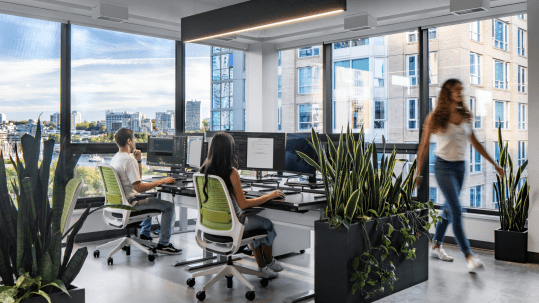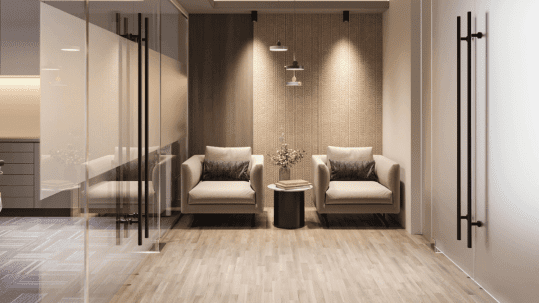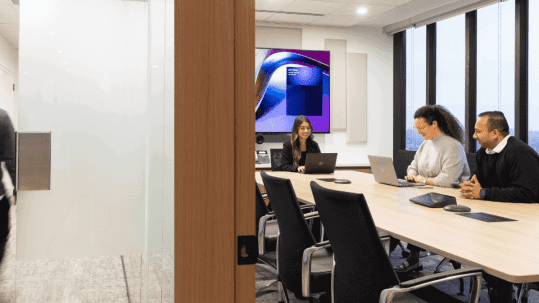Forward-thinking companies understand that their main goal is to create a phenomenal workplace for their people. The heart of every office is its people; they are the wheels that keep the company in motion. For this reason, it’s important to nurture a workplace culture and office environment that is conducive to their success. By keeping employee’s wellness, performance and personal goals, companies will be able to cultivate a positive workplace that gives its employees a sense of purpose and facilitates their success.
However, as the office has historically been a place associated with stress, it can be difficult to imagine an office environment that actually does the opposite. So, how does one begin to create an office environment that promotes deep thinking, innovation, creativity and collaboration? Thankfully, organizational psychologists have created a better way to understand human performance by blending opportunity, motivation, and ability.
Performance: Three Major Factors
When it comes to performance, there are three major factors at play including opportunity, motivation, and ability. Opportunity is about how accessible a person is to amenities or resources. Motivation is the measure in which a person wants to perform a task. Ability pertains to whether or not the person can perform the task at hand. With this in mind, the question becomes: how do workplaces provide opportunities and keep employees motivated while also catering to their abilities, all in the confinements of an office space?
According to organizational psychology, there are ten key design elements that not only support performance factors but also positively impact the atmosphere of any given workplace environments. These design elements include:
- Sensory Variability and Change
- Noise Control
- Thermal Temperature and Comfort
- Colour
- Access to Daylight, Views, and Nature
- Indoor Air Quality
- Crowding
- Employee Engagement
- Ergonomics and Human Factors
- Choice
In the next section, each of these key elements will be elaborated upon to show what they mean for the workplace.
Sensory Variability & Change
Employees prefer sensory variability and change. If an employee is faced with a lack of visual stimulation, such circumstances can affect their ability to stay alert and dull their senses. In addition to this, human productivity can be hindered by workstations that are all the same height and remain neutral-coloured. To avoid productivity loss, try to have moderate levels of visual complexity, spatial variability, materials that offer a sensory experience for the mind, windows that offer views to the outdoors, and access to daylight.
Noise Control
Believe it or not, noise can be a major issue in the workplace environment. In many instances, noise in a workplace can even enable or disable productivity in the workplace depending on the work being performed. To eliminate this loss in productivity, allow employees access to a space with acoustical separation and a door when needed.
Temperature & Thermal Comfort
Thermal comfort requires the right amount of humidity, airflow, and temperature. To provide physical comfort in the workplace, you’ll need to be operating on all of these cylinders. If you happen to hear about temperature issues in the workplace, it’s likely that humidity and airflow are the culprits. The ideal temperature in the office is 70 degrees, as this temperature is associated with reduced sick leaves and a higher accuracy on tasks. If an employee has control over conditions in their workstation, it increases their productivity.
Colour
How certain colours are perceived depends on life and culture experiences. Brighter colours tend to be associated with task accuracy and higher focus. Blue is meant to cool and calm. Pink is intended to lessen burden, discouragement, loneliness, and aggression. Red is commonly associated with ambition and vitality. Orange eases emotions. Yellow helps people feel alert and clear-headed. Having your workplace a certain colour can significantly affect how your employees approach their work.
Access to Daylight, Views, and Nature
People tend to enjoy being surrounded by the great outdoors, which can offer an endless amount of sensory change and variation. Biophilia, the bond between other living systems and humans, is important to offer when people are indoors. It can also be beneficial for workers to spend time outdoors (even if it’s brief) during a workday.
Indoor Air Quality
Since most Americans spend at least 90 percent of their time indoors, it’s important to make sure the air quality is healthy. The health of a company’s workforce can affect productivity, sick days, and health insurance costs. Going beyond simple ergonomics and human factors, the workplace should make good health a priority.
Crowding
Whenever an employee feels crowded, they often feel stressed. Sadly, this feeling can impact how they feel in the workplace. Although the idea of space varies depending on gender, individual preferences, and cultural background, any level of discomfort can cause a significant amount of stress on an individual and impact their work output.
Employee Engagement
When it comes to worker satisfaction and employee engagement, there’s a direct correlation. In short, ensuring your employees are engaged and motivated will facilitate innovation and productivity.
Ergonomics and Human Factors
Workplaces should aim to be designed around and for individuals who are looking to be flexible, comfortable, and support long term productivity. Why? Well, workplaces should consider the limitations and needs of the individuals who will be occupying them. “Human factors” is a term utilized in workplace psychology that touches on topics that include human-computer interaction, human capability, product design, the reduction of human error, workplace safety, and ergonomics. So when it comes to “ergonomics” and “human factors”, the terms are utilized synonymously.
Choice
The workplaces of today require high levels of collaboration, concentration, and everything in between. A well-designed workplace must provide opportunities for choice to be made by employees and customers alike. From here, both parties will have an easier time determining how (and when) they shall utilize your workplace for the benefit of your company.
Considering the information above, there’s plenty of ways companies can adapt their offices for improved workplace wellness. If you haven’t adapted your workplace place yet, these tips are an excellent way to get started. For more tips on how to promote wellness and wellbeing in your workplace, get in touch! We would be happy to provide you with a complimentary design consultation.






